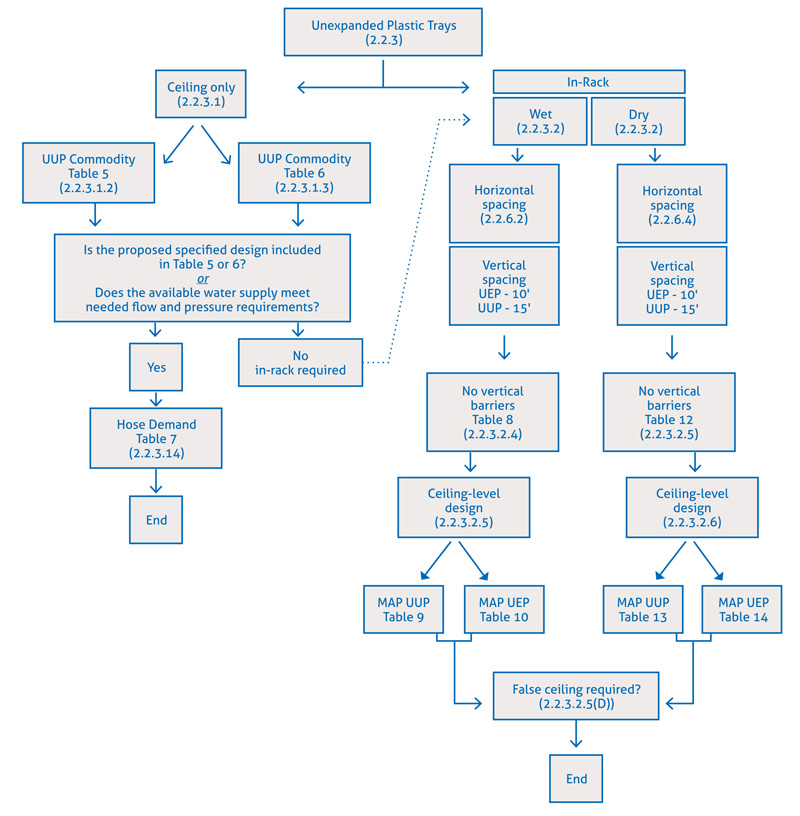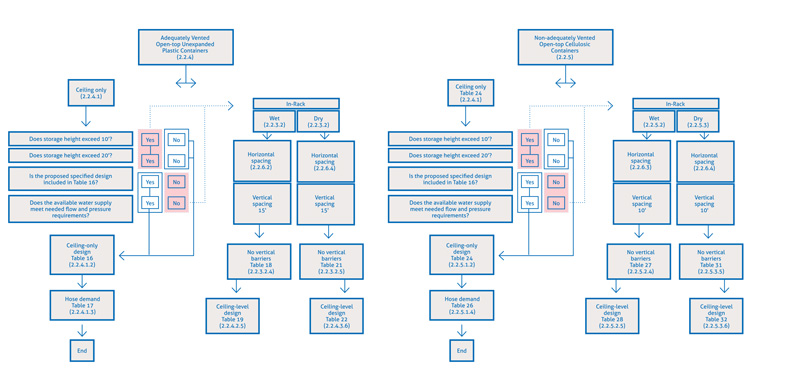
30 Nov Automated robots can be daunting
Those who work in the order fulfilment, materials handling, warehousing, distribution or manufacturing industries, are familiar with automated storage and retrieval systems (ASRS). These robotic tools are being utilised as they can increase productivity and efficiency. However, as a local fire code official, or authority having jurisdiction, an ASRS may be something new or not often interacted with so, here Aaron Johnson, Chief Fire Strategist introduces ASRA.
An automated storage and retrieval system is best defined as an automated system that stores item in a compact footprint and allows for easy and rapid retrieval when needed. These systems are typically composed of two primary components. One of these components is specialised rack storage for the holding of the goods to be retrieved. The other component is the automated robots that are used for retrieving and returning the goods to, or from, the rack storage. There are many variations of these systems, but they typically fall under one of three primary categories – mini-load or shuttle-type, top loading, or vertically enclosed.
Mini-load or shuttle-type systems utilise trays or small totes and containers for material handling. Robotic shuttles then move across the floor and within the rack spaces to retrieve items. The primary difference between a mini-load and shuttle-type system is the rack structure that the totes or containers are stored on.
Top loading systems consist of a metal grid structure under which open-top containers are stacked on top of each other in vertical columns. Items within the containers are accessed from the top of the grid by robots.
Vertically enclosed systems work with a vertical lift system or a vertical carousel. A robotic picker stores and removes trays that rest on fixed storage supports within the unit. A carousel conveyor system uses a rotating storage arrangement that brings the storage tray to the user.
The AHJ Review process
Prior to starting the review process for automated warehousing and the ASRS, the fire code official must have a firm understanding of the operations, processes, functions, and systems to be used. Information that will be needed falls into five categories. These categories are general information, fire sprinkler requirements, fire alarm requirements, system specific standards, and pre-incident planning.
These systems and their components present specific fire protection challenges. A fire code official is accustomed to turning to the International Fire Code or a publication from the National Fire Protection Association for guidance on fire protection requirements. However, the IFC and NFPA do not have clearly set guidelines for the protection of automated warehousing and their automated storage and retrieval systems. To adequately protect these facilities, guidance must be taken from a variety of sources and documents. These include the IFC and the NFPA, FM Global Data Sheets, and the system manufacturers specifications.
NFPA 13, Standard for the Installation of Sprinkler Systems defines an ‘automatic storage type rack’ as an arrangement in which the containers are stored on two racks running perpendicular to the aisle, however, there is no clearly defined sprinkler protection criteria outlined in NFPA 13 for this arrangement. Additionally, the scope of NFPA 13 does not include protection options for open-top containers. When specifying, designing, and approving fire protection systems for a building equipped with an ASRS, FM Data Sheet 8-34, Protection for Automatic Storage and Retrieval Systems should be consulted, in conjunction with, FM Data Sheet 8-9, Storage of Class 1, 2, 3, 4, and Plastic Commodities.
General information to be obtained should include the occupancy classification, type of ASRS to be installed, commodities that will be stored, material composition of trays or containers used for material handling, and maximum storage and ceiling heights.
These facilities will typically be classified as a Group F-1 occupancy (ICC), or a special-purpose industrial facility (NFPA). The type of ASRS to be installed is critical for determining the applicable codes and standards and relevant sections. Figure 1, from FM DS 8-34, provides a flow chart. Following the flow chart for the system type – mini-load, top load, vertically enclosed – will direct the user to the applicable fire protection requirements of the document.
Commodities are classified as Class 1, 2, 3, 4, or plastics only. These classifications are defined in FM Data Sheet 8-1, Commodity Classification. The commodity classification should be based on the types of items that will be stored within the containers. The fire protection systems should be designed based on the highest hazard of commodity classification that will be present.
The trays or containers used for material handling will be cartoned or uncartoned. These can be expanded or unexpanded plastics. These are clearly defined within FM DS 8-34.
The maximum storage height and ceiling heights must be known in order to properly design the fire sprinkler system. The maximum storage height cannot exceed forty feet.
With this general information obtained. The AHJ, or fire code official, can proceed to the fire sprinkler design requirements. There are four steps that are necessary for determining which sprinkler design criteria within FM DS 8-34 applies. These steps are to first determine the material handling container type. Next, determine the sprinkler system type. This could be a wet system, dry system, pre-action system, or a system to be installed within a refrigerated area. Next determine if the hose demand requirements can be met. Finally, a determination can be made on when and where in-rack sprinklers may be required.
Following the fire sprinkler requirements, a fire alarm system should be installed and properly located. FM Data Sheet 5-48, Automatic Fire Detection, as referenced by FM DS 8-34, minimally requires fire detection devices to be installed at the ceiling level. Further fire alarm system and device installation requirements should follow the guidance of NFPA 72, National Fire Alarm and Signaling Code, and the occupancy specific requirements of the IFC and NFPA.
Manufacturer specifications for the robotic components of the ASRS should be consulted for minimum fire protection and safety requirements. There are two standards that a fire code official may consult for robotic systems safety compliance, one is, NFPA 79, Electrical Standard for Industrial Machinery, the other is, UL2595, General Requirements for Battery-Powered Appliances. Some general requirements for these units include functional emergency stop procedures, with clearly defined rules on when these robots are to stop. One of these is that the robots are to stop whenever there is a fire alarm activation. There should also be a periodic maintenance, testing, and replacement program in place for the robot batteries. Additionally, alarms should indicate when there are system or battery failures or impending failures.
Finally, it is important that the facility management has a good working relationship with the local fire department and first responders. The facility personnel should reach out and schedule a site visit with the emergency response personnel. From this site visit a pre-incident plan can be established. The plan should address the following components:
- Overview of the system, components, normal operations.
- Emergency plans and shut-down procedures.
- How to access fires within the storage array.
- How to disassemble the storage array (tools needed, techniques, etc.).
- How many containers may be removed to get to the seat of a fire within the storage system.
- Resources are necessary to return the system to normal operations.
- Knowledge on specialised firefighting equipment on-site (hose stations, monitors, fire detection, etc.).
Automated storage and retrieval systems, with their many integrated components and independent parts, can seem daunting upon first encounter. Following a systematic process for review will help to ensure that all critical items are addressed. Compiling, and referring to, a wide variety of resources – NFPA, FM Data Sheets, and manufacturers specifications – will lead to a safe and compliant installation.
ASRS Fire Code compliance checklist for AHJ (sample)
1.0 General Information
- Occupancy classification information –
- IFC Group F-1
- NFPA 101, Special-purpose industrial occupancy
- What commodities are being stored?
- Class 1, 2, 3, 4, and plastics only
- Other commodity classifications – what is the highest hazard?
- Design to protect the highest hazard.
- Information required on plans for review:
- Maximum commodity hazard to be protected
- Material composition of trays/containers used for material handling
- Cartoned unexpanded plastic (CUP)
- Cartoned expanded plastic (CEP)
- Uncartoned unexpanded plastic (UUP)
- Uncartoned expanded plastic (UEP)
- Types of trays/containers use for material handling
- Open-top, adequately vented solid-walled
- Unexpanded plastic trays
- Maximum storage height [not to exceed 40’]
- Maximum ceiling height over storage area
2.0 Fire Sprinkler Protection Requirements and Guidelines
- Are ceiling level heads at least 3 feet from top of storage?
- Are in-rack sprinkler heads at least 4 in from top of storage?
- Minimum sprinkler head temperatures:
- 100 degrees F or less ambient – 160 degree head, K11.2
- 100 degrees F or more ambient – 212 degree head
- Are the same heads installed throughout? State reason for change, if not.
- Is ceiling construction unobstructed? See FM DS 8-34, section 2.1.4.3.3 Table 1, for installation/design requirements.
- Unobstructed ceiling design area shown is 768 sqft?
- Obstructed ceiling design area per section 2.1.4.4.2?
- Determine storage container method to be utilised:
- Unexpanded plastic trays
- Adequately vented, open-top vented plastic containers
- Non-adequately vented, open-top cellulosic containers (cardboard box on tray)
- What type of sprinkler system is being used?
- Wet
- Dry
- Pre-action (non-interlocked or single-interlocked) Refrigerated area (antifreeze solutions of 20-30% propylene glycol or NFPA allowance) **see appropriate flow chart for required design criteria**
- Water delivery does not exceed 40 seconds at hydraulically most remote sprinkler?
- Are hose stations required (at AHJ’s discretion)?
- Where required, do they meet the following criteria:
- Minimum flow of 50 gpm at most remote two stations
- Are they wet or dry barrel?
- Are they appropriately spaced?
3.0 Fire Alarm Requirements and Guidelines
- Is ceiling-level fire detection properly installed?
- Is an NFPA 72 system installed throughout (based on IFC or NFPA requirements)?
- Do the following functions occur on alarm activation?
- Signal is sent to a constantly attended location
- Robots are automatically shut-down
4.0 Robotic Systems
- What standard is the robotic system designed to?
- Is a periodic maintenance, testing, and replacement program for the batteries in place?
- Are emergency stop procedures functional?
- Is an alarm management program in place? At a minimum, alarms should indicate for the following conditions:
- Robot power board hardware failure
- Robot battery system temperature
- Robot battery health indicator
5.0 Pre-Incident Planning
- Is there an emergency plan in place?
- Date of fire department pre-plan visit
- Has a contact list of building managers and responsible parties been provided?
- Has a pre-incident plan been created? Plan to include:
- System and operational overview
- Emergency and shut-down procedures
- Fire extinguishment access concerns and methods
- Disassembly instructions and resources
- Resources needed for return to normal operations
- Specialized firefighting equipment on-site
Below is a flow chart example that shows how to locate the required sprinkler design information within FM DS 8-34. These examples are based on a mini-load or shuttle type ASRS. Selection of the correct flow chart starts with the material handling container type.






Sorry, the comment form is closed at this time.